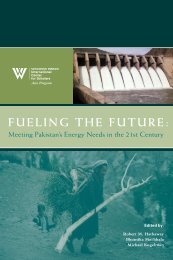1962: The Eve of the Left Turn in China's Foreign Policy - Claude Arpi
1962: The Eve of the Left Turn in China's Foreign Policy - Claude Arpi
1962: The Eve of the Left Turn in China's Foreign Policy - Claude Arpi
You also want an ePaper? Increase the reach of your titles
YUMPU automatically turns print PDFs into web optimized ePapers that Google loves.
war <strong>in</strong> South Vietnam to such an extent as to <strong>in</strong>vite a large-scale American military<strong>in</strong>tervention. Beij<strong>in</strong>g stressed Hanoi, aga<strong>in</strong> and aga<strong>in</strong>, to that it “must liberate <strong>the</strong>South,” but must also pay attention to <strong>the</strong> tactics <strong>of</strong> its struggle, not<strong>in</strong>g <strong>the</strong> differencebetween rural and urban areas. <strong>The</strong> Vietnamese should adopt a “flexible strategy,” and“comb<strong>in</strong>e political struggles with military struggles.” 37 Until mid 1961 Ch<strong>in</strong>acont<strong>in</strong>ued to declare publicly that it supported Vietnam’s struggle to “strive for <strong>the</strong>peaceful unification <strong>of</strong> <strong>the</strong> mo<strong>the</strong>rland” accord<strong>in</strong>g to <strong>the</strong> Geneva agreements. 38 Thosepublic declarations should not be considered as part <strong>of</strong> a propaganda campaign. Indeed,<strong>the</strong>y <strong>in</strong>dicated that Beij<strong>in</strong>g did not want <strong>the</strong> VWP completely to give up efforts to strivefor peaceful unification.Ch<strong>in</strong>a’s persistent effort toward a peaceful resolution <strong>of</strong> <strong>the</strong> Laos crisis dur<strong>in</strong>g thisperiod may better reflect <strong>the</strong> characteristics <strong>of</strong> its Indoch<strong>in</strong>a policy. Border<strong>in</strong>g Laos,Ch<strong>in</strong>a was more directly threatened by American military <strong>in</strong>tervention <strong>the</strong>re than <strong>in</strong>South Vietnam. Moreover, <strong>the</strong> situation <strong>in</strong> Laos was more complex and explosive.<strong>The</strong>refore, Ch<strong>in</strong>ese leaders were more occupied by <strong>the</strong> Laos crisis and <strong>in</strong>vested muchmore energy <strong>in</strong> manag<strong>in</strong>g it. As a result, PRC policy toward <strong>the</strong> Laos issue was muchmore clear-cut and stable than its policy toward Vietnam. Ch<strong>in</strong>a was active <strong>in</strong>conven<strong>in</strong>g <strong>the</strong> Geneva Conference to resolve <strong>the</strong> Laos crisis, and played an importantrole <strong>in</strong> <strong>the</strong> f<strong>in</strong>al sign<strong>in</strong>g <strong>of</strong> <strong>the</strong> Neutral Statement Concern<strong>in</strong>g Laos and its relatedagreements. 39<strong>The</strong> importance <strong>of</strong> Ch<strong>in</strong>a’s Laos policy cannot be overstated, not only because itsuccessfully defused <strong>the</strong> explosive situation <strong>in</strong> Indoch<strong>in</strong>a and postponed <strong>the</strong> American<strong>in</strong>tervention <strong>in</strong> <strong>the</strong> region, but also because it implied cont<strong>in</strong>uity <strong>in</strong> Ch<strong>in</strong>ese foreignpolicy. <strong>The</strong> PRC leaders almost replicated <strong>the</strong> th<strong>in</strong>k<strong>in</strong>g, assessments, and strategicchoices <strong>the</strong>y had made <strong>in</strong> <strong>the</strong> 1954 Geneva Conference. <strong>Eve</strong>n when <strong>the</strong>y regarded <strong>the</strong>37 Yang Kuisong, Mao Zedong yu y<strong>in</strong>duzh<strong>in</strong>a zhanzheng (Mao Zedong and <strong>the</strong> Indoch<strong>in</strong>a War); Li Danhui, ed.,Zhongguo yu y<strong>in</strong>gduzh<strong>in</strong>a zhanzheng (Ch<strong>in</strong>a and <strong>the</strong> Indoch<strong>in</strong>a War), (Hongkong: tiandi tushu chubanshe,2000):.36; Zhongyue guanxi yanbian sishi nian (Four Decades <strong>of</strong> Changes <strong>in</strong> S<strong>in</strong>o-Vietnamese Relations), p. 67.38 “Zhou Enlai zhongli zai huany<strong>in</strong>g yuenan Fang Wentong zongli de guoyan shang de jianghua” (Premier ZhouEnlai’s Speech at <strong>the</strong> Reception for Welcom<strong>in</strong>g Vietnamese Premier Van Tien Tung), June 12, 1961, <strong>in</strong> Zhonghuarenm<strong>in</strong> gongheguo duiwai guanxi wenjianji (1961) (<strong>The</strong> Collection <strong>of</strong> <strong>the</strong> Documents <strong>of</strong> <strong>the</strong> <strong>Foreign</strong> Relations <strong>of</strong><strong>the</strong> PRC, 1961), Vol. 8 (Beij<strong>in</strong>g: shijie zhishi chuban she, <strong>1962</strong>): 181.39 Jiejue laowo wenti de kuoda de r<strong>in</strong>eiwa huiyi wenjian huibian (<strong>The</strong> Collection <strong>of</strong> <strong>the</strong> Documents for <strong>the</strong> EnlargedGeneva Conference for <strong>the</strong> Resolution <strong>of</strong> <strong>the</strong> Laos Issues) (Beij<strong>in</strong>g: shijie zhishi chubanshe, <strong>1962</strong>): .2-11.14

















